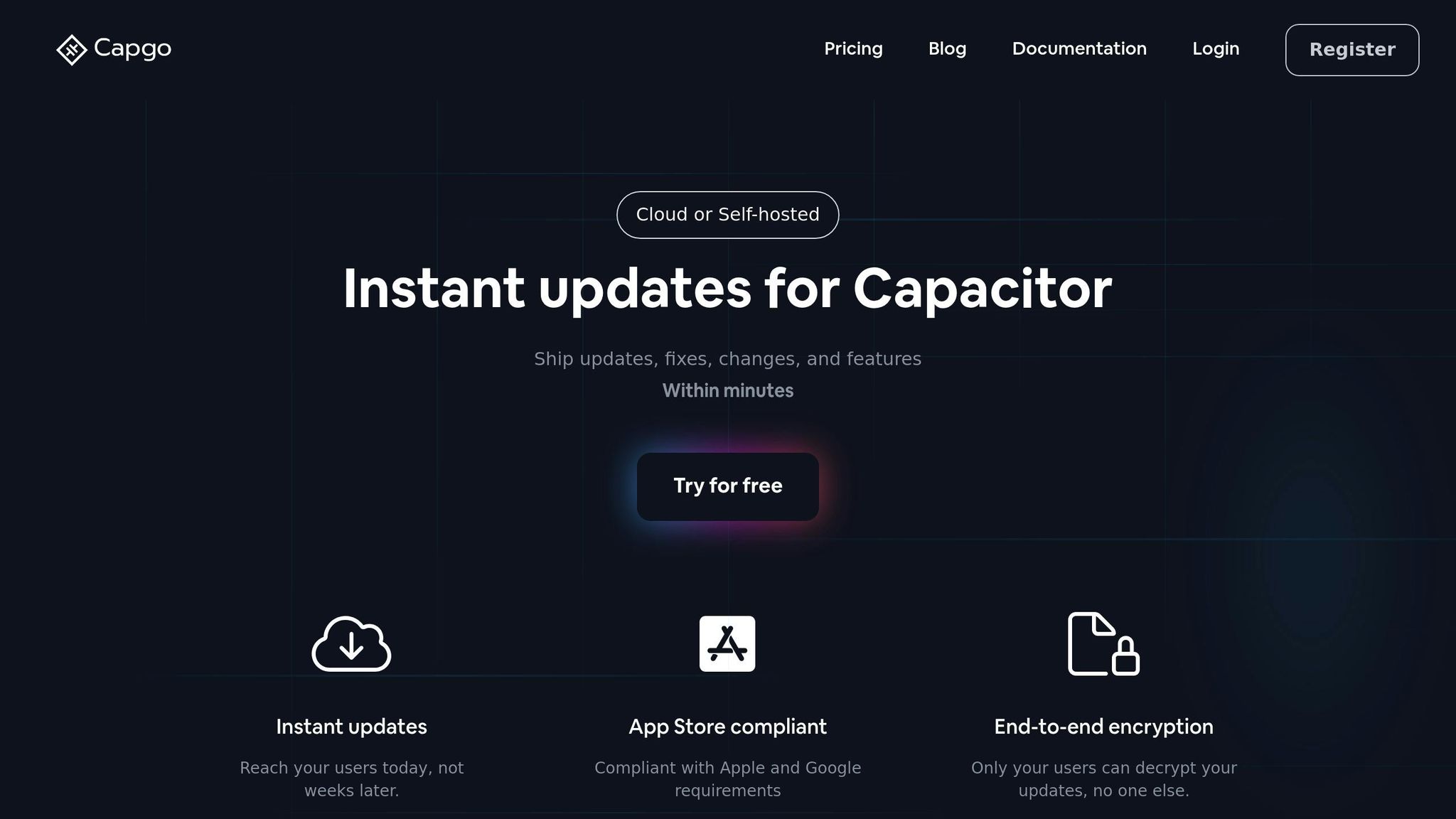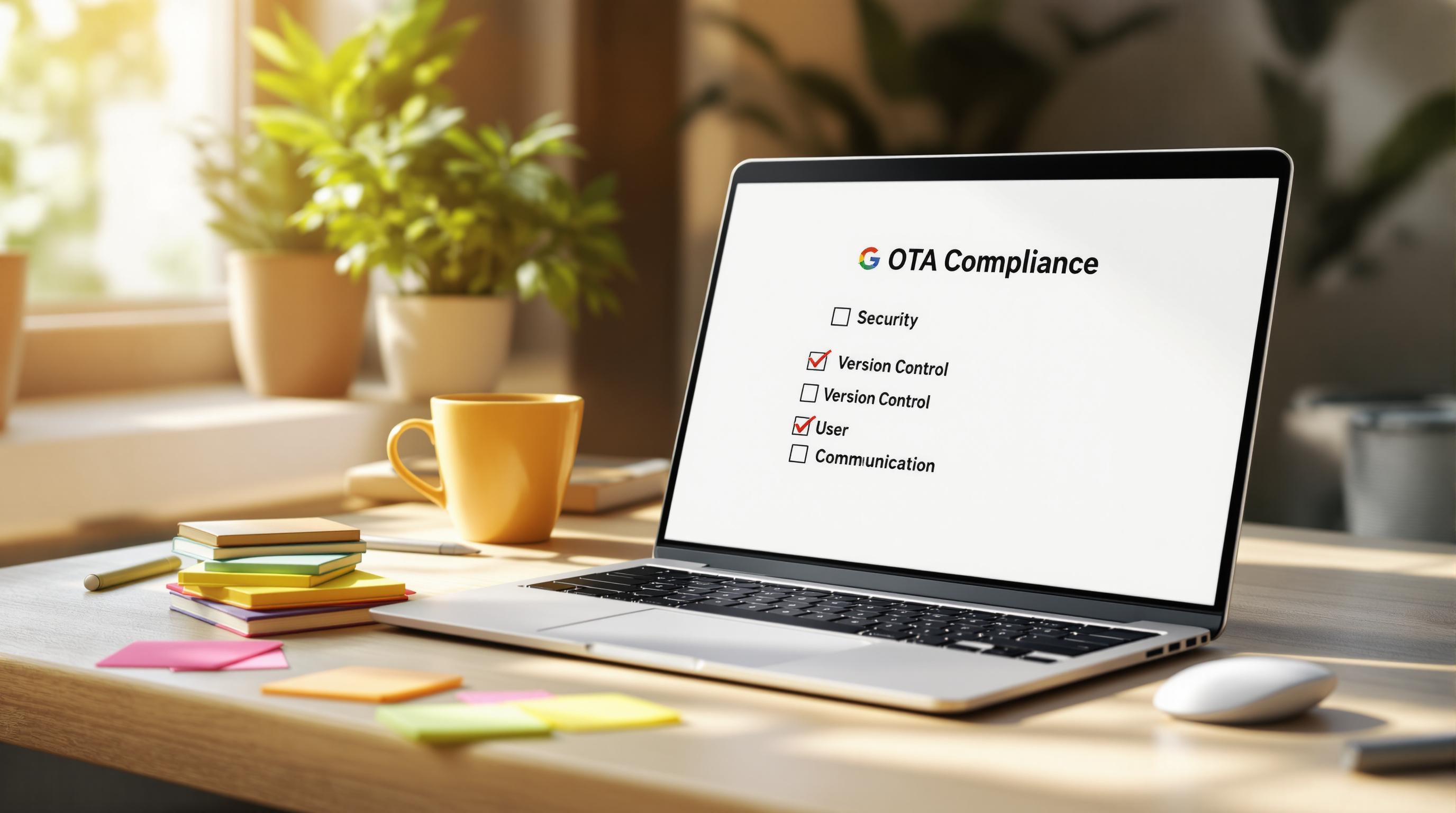Over-The-Air (OTA) updates let you push changes directly to users, bypassing store reviews. But to stay compliant with Google Play policies, you need to follow strict rules for security, transparency, and quality. Here’s a quick overview:
- Security: Use end-to-end encryption and sign update packages to protect user data.
- Version Control: Track updates with semantic versioning, include rollback options, and document changes.
- User Communication: Notify users about updates, clarify changes, and respect permissions for manual approvals.
- Testing: Test updates for functionality, compatibility, and security before rolling out.
- Phased Rollouts: Start small (5-10% of users), monitor performance, and scale gradually.
- Performance Metrics: Aim for a >98% update success rate, <0.1% crash rate, and <5MB package size.
Tools like Capgo make compliance easier with features like instant rollback, real-time monitoring, and secure update delivery.
Quick Summary Table
| Compliance Area | Key Requirement | Target Metric |
|---|---|---|
| Security | End-to-end encryption | 82% global success rate |
| Version Control | Rollback & phased releases | 95% adoption in 24 hours |
| User Communication | Clear update alerts & permissions | Inform users effectively |
| Quality Assurance | Rigorous testing protocols | <0.1% app crash rate |
Follow these steps to keep your app updates fast, secure, and compliant.
Stay Ahead with Google Play’s Essential Policy Update for …
Creating Update Packages
OTA update packages need to align with Google Play’s security and version control standards. This ensures updates run smoothly and protect user data. Below are the core guidelines for version control and security.
Version Control Standards
Version control for OTA updates demands clear organization and thorough documentation. Each update package should include:
- Unique version ID: Use semantic versioning (e.g., 2.1.3) to keep track of changes.
- Change manifest: List all modifications and fixes in detail.
- Compatibility markers: Specify the app versions and devices the update supports.
- Rollback information: Include references to earlier versions to allow safe reversion if needed.
This level of documentation makes troubleshooting much easier.
Security Requirements
Strong security measures are critical for OTA updates to meet Google Play’s standards. Two essential practices include using end-to-end encryption and signing update packages.
As Capgo’s development team explains, “The only solution with true end-to-end encryption, others just sign updates” [1]. Regular security audits and adherence to industry best practices help ensure updates remain secure and trustworthy.
Update Distribution Safety
These measures help protect user data and ensure updates remain stable. By implementing strict security protocols, you can meet Google Play’s standards and deliver dependable updates.
Data Protection Methods
Encryption is key to secure over-the-air (OTA) distribution. The most reliable approach is end-to-end encryption, which safeguards update packages throughout the entire transmission process. Simply signing updates isn’t enough - end-to-end encryption ensures only your users can access the updates.
“End-to-end encryption. Only your users can decrypt your updates, no one else.” [1]
Pair encryption with strong recovery strategies to maintain seamless service.
Update Recovery Options
A solid recovery system minimizes the impact of update failures and keeps apps stable. Include automatic rollback features and keep archives of recent stable versions for quick fixes.
| Recovery Component | Purpose | Priority |
|---|---|---|
| Rollback Mechanism | Restore the previous version | Critical |
| Version Archive | Maintain backup versions | High |
Together, these tools create a secure and efficient update process that safeguards both compliance and the user experience.
User Communication Standards
Clear and effective communication with users plays a key role in ensuring compliance with Google Play requirements for updates.
Update Alerts
Google Play requires clear notifications for pending updates to keep users informed and maintain compliance.
| Alert Type | Purpose | Implementation |
|---|---|---|
| Background Updates | Install updates automatically | Silent notification after completion |
| Feature Updates | Notify users about major changes | In-app notification before updating |
| Security Updates | Inform users about critical fixes | High-priority notification with details |
Permission Requirements
Different types of over-the-air (OTA) updates require specific levels of user permissions:
- Used for smaller patches and minor fixes.
- No action needed from the user [1].
Manual Approval
- Recommended for major updates with new features.
- Allows users to decide when to install.
- Must include a clear explanation of the changes.
These permission levels ensure users remain informed while giving them control over significant updates.
Update Documentation
Always provide brief and clear update notes that include essential details such as version numbers, security fixes, feature changes, and resolved bugs. For beta testing or staged rollouts, use dedicated channels to collect early feedback.
Key Details to Include:
- Version number
- Security updates
- Feature changes
- Bug fixes
“End-to-end encryption. Only your users can decrypt your updates, no one else.” [1]
This approach keeps users informed and ensures updates are both efficient and compliant with Google Play standards.
Quality Control Steps
Once updates are securely distributed, thorough quality control ensures they work as intended. These steps build on earlier security and communication measures to guarantee updates perform smoothly.
Testing Requirements
OTA updates should be tested in several key areas:
| Test Type | Purpose | Key Checks |
|---|---|---|
| Functionality | Verify core features | App launch, critical workflows, data handling |
| Network | Test connectivity | Performance under varying network conditions |
| Device | Ensure compatibility | Different Android versions, screen sizes |
| Security | Check protection | Encryption integrity, secure data transmission |
Automating these tests helps maintain consistency and reduces the chance of errors.
Phased Release Process
Roll out updates gradually, starting small and expanding as stability is confirmed:
- Initial Release: Roll out to 5-10% of users.
- Monitoring Period: Observe performance for 24-48 hours.
- Expansion Phase: Increase rollout in 20% increments.
- Full Release: Deploy to all users after confirming stability.
“We rolled out Capgo OTA updates in production for our user base of +5000. We’re seeing very smooth operation almost all our users are up to date within minutes of the OTA being deployed to @Capgo.” - colenso, @colenso [1]
Performance Tracking
Track these key metrics during and after deployment:
| Metric | Target | Action Threshold |
|---|---|---|
| Update Success Rate | >98% | <95% triggers investigation |
| Installation Time | <30 seconds | >1 minute requires optimization |
| App Crash Rate | <0.1% | >0.5% initiates rollback |
| Network Usage | <5MB/update | >10MB needs package optimization |
Analytics and error tracking tools are essential for identifying and resolving issues quickly. Instant rollback features are critical to maintaining service quality if something goes wrong.
“We practice agile development and @Capgo is mission-critical in delivering continuously to our users!” - Rodrigo Mantica, @manticarodrigo [1]
For beta testing and staged rollouts, use channel systems to target specific user groups with different versions. This controlled approach ensures thorough testing while staying compliant with Google Play Store requirements.
Capgo Compliance Tools

Capgo builds on strict update and security protocols to provide tools designed for compliance. With over 23.5 million updates delivered across 750 production apps [1], Capgo ensures smooth updates while meeting key standards. These tools are grounded in principles like version control, security, and quality assurance.
Security Features
Capgo incorporates advanced security features tailored to meet Google Play’s requirements:
| Security Feature | Implementation | Compliance Benefit |
|---|---|---|
| End-to-End Encryption | True encryption, not just signing | Protects updates from tampering |
| Secure CDN | Global distribution in 114ms | Delivers updates quickly and reliably |
| Version Control | One-click rollback | Ensures stability to meet Play Store standards |
Development Integration
Capgo easily fits into existing development workflows while adhering to Google Play’s compliance rules:
| Integration Type | Feature | Compliance Aspect |
|---|---|---|
| CI/CD Pipeline | Supports GitHub Actions, GitLab CI, Jenkins | Automates compliance checks |
| CLI Tools | One-command deployments | Standardizes the update process |
| API Access | Public API for custom setups | Offers flexible compliance management |
| Channel System | Beta testing and staged rollouts | Enables controlled update releases |
OTA updates start at $12 per month. For teams needing automated CI/CD pipelines to build native mobile apps, an optional setup service is available for $2,600 one-time.
Update Management
Capgo provides tools to manage updates effectively while aligning with Google Play’s compliance standards:
| Management Tool | Success Metric | Compliance Impact |
|---|---|---|
| Analytics Dashboard | 95% update adoption within 24 hours | Monitors user adoption rates |
| Error Tracking | 82% global success rate | Tracks update stability |
| Partial Updates | Average bundle size of 5MB | Improves delivery efficiency |
| Organization Controls | Granular permissions | Secures update authority |
“We practice agile development and @Capgo is mission-critical in delivering continuously to our users!” - Rodrigo Mantica [1]
Capgo also offers flexible hosting options, including cloud-based and self-hosted solutions. These options allow organizations to maintain control over their update infrastructure while meeting Google Play’s security standards. Features like real-time monitoring and instant rollback help achieve the 82% global success rate benchmark.
Summary
Checklist Review
Meeting Google Play OTA compliance requires attention to security, version control, user management, and quality assurance. Here’s a breakdown:
| Compliance Area | Key Requirements | Success Metrics |
|---|---|---|
| Security | End-to-end encryption | 82% global success rate |
| Version Control | Rollback capability, phased releases | 95% update adoption in 24 hours |
| User Management | Permission controls, update alerts | 23.5M updates successfully delivered |
| Quality Assurance | Testing protocols, performance monitoring | 750+ production apps compliant |
Staying on top of these requirements helps avoid rejections and ensures smooth app operations.
Using Capgo
Capgo provides tools designed to streamline compliance with Google Play standards. With its features, developers can manage millions of updates across various apps seamlessly [1].
“Capgo is essential for developers - enabling seamless bug fixes without store review” [1]
Key Features and Advantages:
| Feature | Advantage | Implementation |
|---|---|---|
| Instant Updates | Fix bugs quickly without store delays | CI/CD pipeline integration |
| Security Protocol | End-to-end encryption | - |
| Update Control | Granular permissions for updates | User-specific deployment |
| Performance Tracking | Real-time monitoring | Analytics dashboard |
Capgo’s channel system allows for controlled update distribution, ensuring updates are delivered efficiently while staying compliant with Google Play policies. Features like one-click rollback and error tracking help teams maintain update stability and quickly address any issues that arise.




